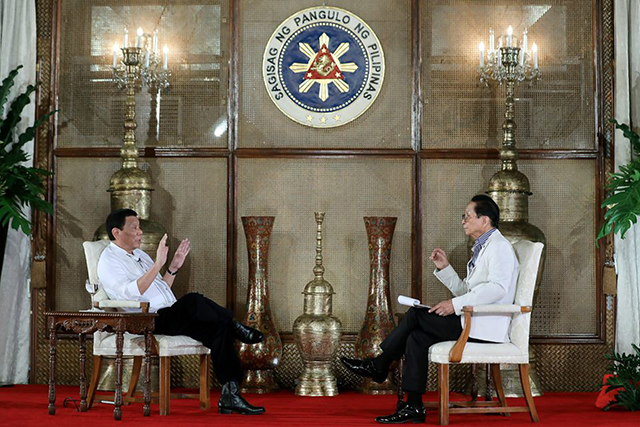The Duterte Talk Show: Media Saw Through the Subterfuge

Photo from PCOO’s Facebook page.
MALACAÑANG ANNOUNCED last September 10 President Rodrigo Duterte’s desire to “speak to the nation.” But Presidential Spokesperson Harry Roque did not disclose what he would be talking about on the following day. (“Duterte ‘speaking to nation’ on September 11”)
Without a clue as to the subject of the president’s address, the public ended up speculating on what it could be. On social media, some netizens said they hope he would finally address the country’s economic woes. Some recalled rumors about his possible resignation, while others feared he would declare martial law, since September 11, 2018 was Ferdinand Marcos’ 101st birth anniversary. Media scrambled to report all this, devoting precious time and effort to the monitoring of the supposedly momentous event.
But the much-anticipated presidential address turned out to be a huge letdown for both the press and the public. Unlike the earlier scheduled press conference, it turned out to be just a conversation between the president and his legal counsel Salvador Panelo.
The palace claimed that what it inaccurately described as a “tete-a-tete” (the phrase refers to a private conversation between two people) was an opportunity for the president to be heard after his revocation of Sen. Antonio Trillanes IV’s 2011 amnesty hogged media attention for two weeks. (“Palace: Duterte’s tête-à-tête to level playing field with Trillanes”)
It was nevertheless a clear attempt to set the news agenda. Fortunately, neither print nor broadcast media fell for it. Instead of merely echoing the president’s statements on several issues, the media questioned the need for the president’s address and looked into the reason why the press briefing format was modified into a “tete-a-tete.”
CMFR monitored reports from the three Manila broadsheets Manila Bulletin, the Philippine Daily Inquirer and The Philippine Star; the primetime newscasts 24 Oras (GMA-7), Aksyon (TV5), News Night (CNN Philippines) and TV Patrol (ABS-CBN 2), and online news websites Rappler and InterAksyon from September 11 to 15, 2018.
From national address to “tete-a-tete”
On the same day, Philstar.com attempted to look into the reason behind the sudden shift of format from the original press conference to the “showbiz-type” one-on-one interview, recalling in detail what had transpired earlier. The report highlighted the conflicting statements of the Presidential Communications Operations Office (PCOO), Special Assistant to the President Christopher “Bong” Go, Panelo and Roque. (“From national address to one-on-one talk: Palace announcement confuses public”)
An hour before the scheduled briefing, Communications Undersecretary Feducia Mia Reyes-Lucas told reporters in a press advisory that she “would like to relay that the PRRD Press Conference is no longer included in today’s activities.”
However, Roque insisted that the palace had not canceled the conference, but had only “modified” the format.
All the primetime newscasts that aired in the evening of September 11 focused on trying to make sense of this confusion, with their correspondents providing chronological accounts of the events. (“Presscon ni PDu30, naging talastasan sa pagitan niya at ni Chief Legal Counsel Panelo”)
But Malacañang did not explain why Duterte made the change.
The president’s words
For an hour-and-a-half, Panelo’s rehearsed questions tried to get the president’s stand on several issues but the president kept circling back to Trillanes’ amnesty case and the alleged destabilization plot against him by the Magdalo group, the Liberal Party, and the Communist Party of the Philippines.
CMFR cheers Rappler and PhilStar.com for reports on some of the topics addressed during the president’s conversation with Panelo, among them the voiding of Trillanes’ amnesty, the supposed ouster plot, inflation, the third participant in the country’s telecommunications service, and Boracay’s re-opening. (“Things Duterte said in his one-on-one interview with Panelo,” “SUMMARY: What Duterte said during Q and A with Panelo”)
CMFR also notes Rappler’s effort to fact-check the president’s and Panelo’s claims regarding the revocation of Trillanes’ amnesty. (“LIST: False claims of Duterte, Panelo about legal issues on Trillanes amnesty )
The change in format from a press conference to a supposed “tete-a-tete” enabled Duterte to limit the discussion only to those topics he wanted to keep in the news, and what he was most comfortable with. Among the risks of a press conference is the possibility that the journalists present would bring up issues the source would rather avoid, or to ask questions to which he might not have the answers.
The change in format was an attempt by Malacanang to control the media narrative. But thankfully, much of the press saw through the subterfuge.
Leave a Reply